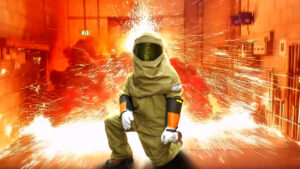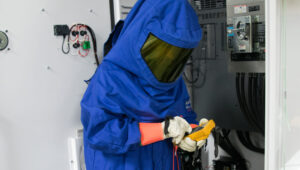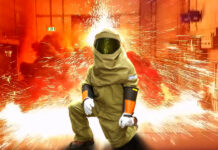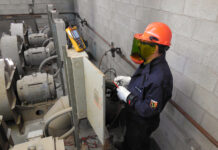The incident energy analysis method uses complex calculations to come up with the incident energy for each individual piece of equipment. “The incident energy exposure level shall be based on the working distance of the employee’s face and chest areas from a prospective arc source for the specific task to be performed” (NFPA 70E 130.5(G)) This complex method can be calculated by pen and paper, but is much more likely to be accurate if done by computerized analysis. This method breaks down PPE into 3 categories as outlined below.
Incident Energy = < 1.2 cal/cm2
- Protective clothing – Non-melting or untreated natural fiber (i.e. untreated cotton, wool, rayon, or silk. Or blends of these materials.) with a fabric weight of at least 4.5oz/yd2
- Shirt (long sleeve)
- Pants (long) or coveralls
- Protective Equipment
- Face shield for projectile protection (as needed)
- Safety glasses or safety goggles (required)
- Hearing protection
- Heavy duty leather gloves or rubber insulating gloves with leather protectors (required)
- Leather footwear
Incident Energy = 1.2 – 12 cal/cm2
- Arc Rated Clothing – Arc rating must be equal to or greater than the estimated incident energy
- Shirt (long sleeve) (required)
- Pants (long) or coveralls (required)
- OR an Arc Flash Suit (required)
- Protective Equipment
- Arc-rated face shield & arc-rated balaclava OR arc flash suit hood (required)
- Arc-rated outerwear (i.e. jacket, parka, rainwear, hard hat liner, etc.) (As needed)
- Heavy-duty leather gloves, arc-rated gloves, or rubber insulating gloves with leather protectors (required)
- Hard hat
- Safety glasses or safety goggles (required)
- Hearing protection
- Leather footwear
Incident Energy = 12 cal/cm2
- Arc Rated Clothing – Arc rating must be equal to or greater than the estimated incident energy.
- Shirt (long sleeve) (required)
- Pants (long) or coveralls (required)
- OR an Arc Flash Suit (required)
- Protective Equipment
- Arc-rated arc flash suit hood (required)
- Arc-rated outerwear (i.e. jacket, parka, rainwear, hard hat liner, etc.) (as needed)
- Arc-rated gloves OR rubber insulating gloves with leather protectors (required)
- Hard hat
- Safety glasses or safety goggles (required)
- Hearing protection
- Leather footwear
(Notice here that the incident energy analysis method has no upper cap on incident energy, whereas the PPE categories method ends at 40 cal/cm2)
Undergarments
The NFPA says “You are permitted to wear flammable garments – not meltable garments – under PPE. Arc-rated PPE does not guarantee that the materials found in your under layer clothing will not melt onto your skin during an incident.” (NFPA 70E 130.7(C) (9)) The fabric of choice for undergarments is usually cotton.
Gloves
Leather gloves must be worn when you need arc flash protection at any level. Leather is not typically arc flash rated. Heavy-duty leather gloves made entirely out of leather with a minimum thickness of 0.03in that are unlined or lined with nonflammable, nonmelting, fabrics have been shown to have arc thermal performance values in excess of 10 cal/cm2. Leather protectors worn over rubber insulating gloves provide additional arc flash protection for the hands. (NFPA 70E Handbook, 130.5(G))
Foot Protection
Footwear with an arc rating is not available. Heavy duty leather footwear or dielectric footwear (or both) provide some arc flash protection to the feet and shall be used in all exposures greater than 4 cal/cm2. You should not wear shoes made from lightweight materials or from materials that are flammable or may melt and drip. In most cases, heavy-duty leather work shoes or boots are satisfactory. (NFPA 70E Handbook 130.7(C) (10) (e))
Outer Layers
Garments worn as outer layers over arc-rated clothing, such as jackets or rainwear, must also be made from arc-rated material. Flammable garments such as jackets, rainwear, or protective gear such as a harness worn over arc-rated clothing can act as a flame source themselves. This provides a heat source for the arc-rated clothing underneath, which potentially exceeds the insulating capacity of the arc-rated clothing (NFPA 70E Handbook 130.7(C) (9) (b)).
Conductive Articles
Conductive articles of jewelry and clothing (such as watchbands, bracelets, rings, key chains, necklaces, metalized aprons, cloth with conductive thread, metal headgear, or metal frame glasses) shall not be worn within the restricted approach boundary or where they present an electrical contact hazard with exposed energized electrical conductors or circuit parts. (NFPA 70E Handbook 130.6(D))
In order to correctly calculate the incident energy of your specific equipment, an arc flash study done by a well-trained engineer is your best bet.
For more information on Arc Flash PPE, Watch our EMC Webinar: Arc Flash Fundamentals
Questions About Arc Flash or PPE? We Can Help!
Call 800-595-5315 Or Connect With Our Expert Technicians Here:
Other Articles
- Lockout/Tagout: An In Depth Look
- How to Assess Your Equipment for Arc Flash Hazards
- Guide to Arc Flash PPE – The Incident Energy Analysis Method



Craig is the Vice President of Engineering at Energy Management Corporation. He is a Professional Engineer (PE) and carries over 30 years of experience in the world of electrical automation. Besides amassing an impressive amount of knowledge in his magnificent brain, he is also a Master Scuba Diver (MSD), a performing magician, and a professional DJ. Truly a man of many talents.






